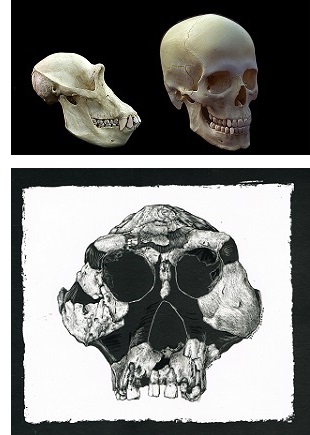***the exhibition is no longer on display***
(Guided tour in Hebrew)
As soon as it was published, Charles Darwin’s theory of evolution raised the obvious question: Could it be that the “crown of creation,” too, was not created as is? If, as the theory proposes, all living things are products of a chain of development from more primitive ancestors, could the same be true of humans?

Given the widespread consciousness of humanity’s uniqueness, along with the influence of well entrenched religious traditions, a positive answer to this question seemed unimaginable. Even Darwin’s collaborator in formulating the theory, Alfred Russel Wallace, agreed that the evolutionary process must be ascribed to the entire living world – except for humans! Darwin himself refrained from the sensitive issue of human origins, but that very abstention only stirred the demand for an authoritative answer.
This natural curiosity regarding our own biological history spurred feverish efforts by scientists, certain that the theory of evolution must apply to humans as well, to find the proof for it. The earliest paleontologists’ expectations were modest: Their ambition was to find evidence of the “missing link” – just one ancient species that could be said to bridge the gap between primal apes and modern humans. When this theoretical entity was actually found, in the form of a fossil, at the end of the nineteenth century, that, from their point of view, sufficed to prove the evolution of humans. Since then many more such links have been unearthed and assigned their presumptive places along the reconstructed path of human evolution. Their large number, and their non-random positions on a continuous developmental path, have substantiated the theory’s validity.
The exhibition on human evolution mounted at the Israel Academy of Sciences and Humanities in Jerusalem presents authentic, highly accurate copies of the fossils attesting to human evolution that have been found in many locations around the world. They include the oldest fossils known to us, which were discovered only recently, and fossils that have not yet been shown in public. Each item is accompanied by detailed information on the species to which it belongs and its importance in reconstructing the process of human development.
Also on display in the exhibition are photos of the reconstructions of fossil species by renowned National Geographic paleoartist John Gurche, a physical anthropologist, including pictures illustrating the process of reconstructing their “soft” anatomy.
Virtual Tour of the Exhibition (Hebrew)